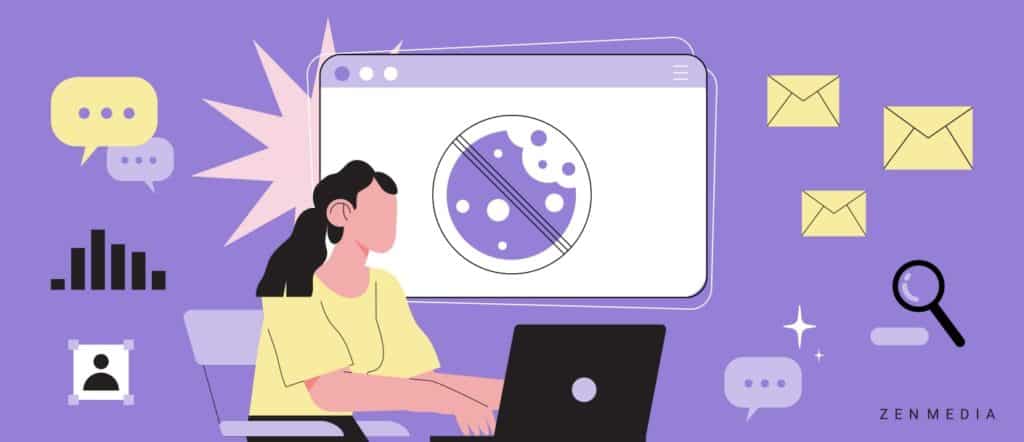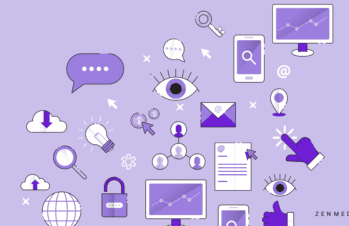No need to alert Cookie Monster; this won’t affect him. You may want to get your CEO on the phone, though, because there is a cookieless future ahead of us. B2Bs must learn to collect, analyze, and store first-party data in a safe and effective way.
Google claims that cookies and the data they collect and aggregate across a searcher’s entire browser history, have led to an “erosion of trust.” As such, Google has promised to eradicate them—originally announcing the decision in January 2020 and now planning to begin phasing them out in the latter half of 2024. The continued delays from Google shouldn’t make marketers comfortable with lagging on crucial updates. Other browsers, including Safari, Firefox, and Brave have already cracked down on cookies. Even with this knowledge, more than 40% of digital marketers and advertisers say they are very or somewhat concerned that a change in cookies would negatively affect their data onboarding requirements and audience targeting.
And despite Google’s extension and a wave of coverage, 38% of marketers say they still aren’t prepared for our cookieless future. (Only 21% feel they are readily prepared for the end of third-party data.) Marketers need to prepare now while they have time to derive insights from their existing data, test new campaigns and targeting, and reap the benefits of the cookies they are used to analyzing while testing their zero- and first-party strategies. (More on those in a minute.)
Our cookieless future is inevitable as our technological world, led by Web3, prioritizes consumer privacy over almost everything. As the B2B marketing landscape evolves, prioritizing customer retention alongside customer acquisition is paramount. To do so, brands need to prioritize zero- and first-party data and full-funnel marketing.
Zero- and First-Party Data
According to Adobe’s 2022 Digital Trends Report, more than half of senior executives (59%) plan to increase their budgets for online media spending in 2022 compared with 2021. But the end of third-party cookies will make customer acquisition more complex and costlier. With privacy concerns ever on the rise, brands need to leverage zero- and first-party data to ensure the consent of the user and details of the insights gained. Zero-party data is data customers voluntarily give brands; it comes from customer surveys and polls, typically doesn’t require any analysis, and offers direct insights. First-party data comes from customer behavior, like web activity, and needs to be analyzed for insights.
Zero- and first-party data enables marketers to engage in a conversation with their customers. These types of data are key to remarketing digital campaigns that target customers with relevant messaging, ads, and products after they’ve engaged with your brand in some way. Because both zero- and first-party data come directly or nearly directly from the source—your consumer—they are thought to have more accurate insights than third-party data. There’s always a silver lining, right?
The ability to further personalize messaging and brand interaction increases the onus on customer retention by using key data points to increase value to consumers and reduce churn. In the end, zero- and first-party data will fuel a full-funnel approach to targeting (and retargeting) prospects.
Related read: The Death of Third-Party Cookies: What It Means for B2B Brands, And What to Do About It
Full-Funnel Marketing
Funnel marketing often assumes a linear path—but the B2B buyer’s journey is anything but. Targeting the top, middle, and bottom of the funnel simultaneously reaches customers wherever they are within their buying journey by providing messaging that caters to their level of interest.
With 27 touchpoints necessary to convert a prospect to a customer, a zero- and first-party-data-informed, full-funnel strategy is essential. And part of that strategy should be long-term influencer partnerships and remarketing campaigns. B2B influencer marketing—just one of many of B2C’s influences on B2B marketing—involves a collaboration between a brand and an individual with a specific niche and sizeable online following. Research shows that brands don’t need to spend every dollar of their budget on A-list influencers. Nano- and micro-influencers have higher engagement rates than creators with higher follower counts.
B2B Marketing Strategies for a Cookieless Future
Prioritizing Customer Retention
Though the shift from third-party data may be concerning for some, there are opportunities in the transition. More than ever, brands will need to build authentic, trustworthy relationships with their audiences; they must prioritize the user experience and improve upon it based on real customer feedback—and in real-time.
This is already the expectation in some B2C markets. While B2B customers expect instant gratification a bit less than their B2C counterparts, they still expect a high level of personalization and engagement, even after the sale. According to a 2021 McKinsey report, 71% of consumers expect companies to deliver personalized interactions—and 76% of them get frustrated when brands don’t deliver. And that’s actually good news for you! If you continue to engage with an already converted customer, you’re building a long-term relationship proven to have a positive impact on your overall ROI.
Leveraging Conversational Marketing
Conversational marketing enables brands to create tools that collect a similar kind of data as third-party cookies would but are entirely zero- and first-party enabled. Conversational marketing tools like chatbots and live chat solutions provide a space for users to engage with your brand on their terms. Likewise, it presents an opportunity for brands to learn more about their site visitors than they would from a form, for example.
Implementing Omnichannel Marketing
Omnichannel marketing is the process of presenting consistent customer experiences through all touchpoints and interactions someone has with a brand. By prioritizing the audience and their intent, omnichannel marketing decenters the brand, products, and services of a company to build customer loyalty. Using a combination of channels like social, paid search, email, and more, brands can build a cohesive strategy that presents as a fluid, single entity no matter where someone runs into it.
While the eradication of third-party cookies significantly affects the marketing industry, there is still time to take advantage of the data you can glean now and to develop a strong zero- and first-party data strategy. Wondering what your brand can do in 2023 to prepare for our cookieless future? Reach out. You bring the (oat) milk, we’ll bring the Oreos.





